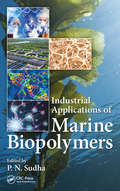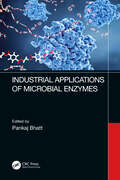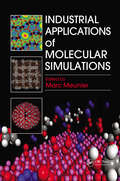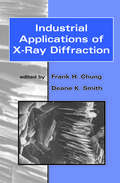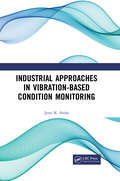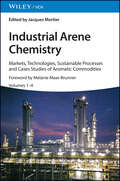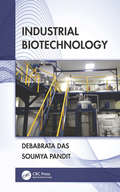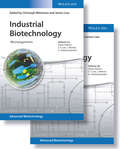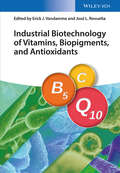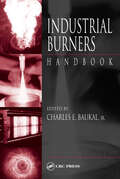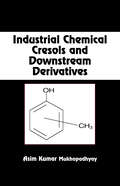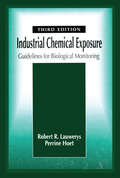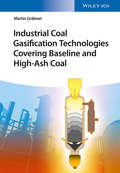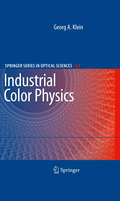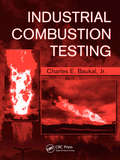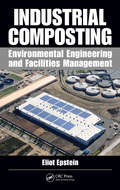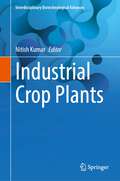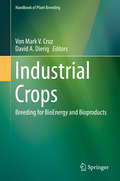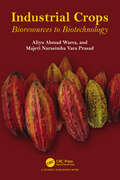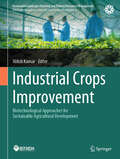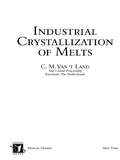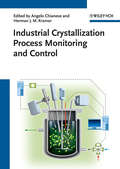- Table View
- List View
Industrial Applications of Marine Biopolymers
by P. N. SudhaIndustrial Applications of Marine Biopolymers presents different classes of marine biopolymers and their industrial applications, demonstrating the precious value of ocean resources to society. This timely volume discusses the exceedingly useful polymers derived from these materials that are biodegradable, biocompatible, and at times water soluble. Direct use or chemically modified forms of such biomaterials have many chemical sites, making them suitable for varied types of industrial applications. In addition, this book also addresses current global challenges of conservation, including extended drought conditions and the need for improved agricultural methods, together with new bio-medical developments. It is suitable for anyone who has an interest in the industrial applications of biopolymers.
Industrial Applications of Microbial Enzymes
by Pankaj BhattMicrobial enzymes are important because they can be used for a wide variety of industrial purposes. There is dispersed and scanty information available with respect to microbial enzymes and their industrial applications. In this edited book, leading scientists have covered the various aspects of microbial enzymes and their industrial applications. Using microbial enzymes can help expedite various manufacturing processes and contribute to sustainable development, which is a priority worldwide. Research gaps in the entrainment of microbial enzymes with their direct application in product development are a major focus of this volume. Key Features• Covers microbial enzymes with comprehensive and in-depth information• Benefits students by describing recent advancements into microbial enzymology• Provides updates regarding microbial enzymes for researchers and industrial scientists• Includes findings on the microbial actions for better life
Industrial Applications of Molecular Simulations
by Marc MeunierThe field of quantum and molecular simulations has experienced strong growth since the time of the early software packages. A recent study, showed a large increase in the number of people publishing papers based on ab initio methods from about 3,000 in 1991 to roughly 20,000 in 2009, with particularly strong growth in East Asia. Looking to the futu
Industrial Applications of X-Ray Diffraction
by Frank H. Chung Deane K. SmithBy illustrating a wide range of specific applications in all major industries, this work broadens the coverage of X-ray diffraction beyond basic tenets, research and academic principles. The book serves as a guide to solving problems faced everyday in the laboratory, and offers a review of the current theory and practice of X-ray diffraction, major
Industrial Approaches in Vibration-Based Condition Monitoring
by Jyoti Kumar SinhaVibration-based condition monitoring (VCM) is a well-accepted approach in industries for early detection of any defect, thereby triggering the maintenance process and ultimately reducing overheads and plant downtime. A number of vibration instruments, data analyzer and related hardware and software codes are developed to meet the industry requirements. This book aims to address issues faced by VCM professionals, such as frequency range estimation for vibration measurements, sensors, data collection and data analyzer including related parameters which are explained through step-by-step approaches. Each chapter is written in the tutorial style with experimental and/or industrial examples for clear understanding.
Industrial Arene Chemistry: Markets, Technologies, Sustainable Processes and Cases Studies of Aromatic Commodities, 4 Volume Set
by Jacques MortierIndustrial Arene Chemistry Explore the wide array of uses for aromatic hydrocarbons in this comprehensive reference Aromatics are a class of compounds—normally but not exclusively organic—which tend to be produced as by-products of various industrial processes. Their importance as petrochemical materials in themselves, along with the range of inter-relations between different aromatic chemicals, creates a complex and opportunity-filled market for aromatics. Industrial Arene Chemistry provides a thorough look at the conventional techniques required to use and produce these aromatic hydrocarbons. Beginning with an overview of the global aromatic market—including, but not limited to, manufacturers, markets of BTX, and downstream functional aromatics, aromatics derived from renewable sources, and economic forecasts—the book will also explore the impact shifting environmental factors will have on the future of aromatic chemistry. The text further explores BTX production processes differentiated according to the raw materials used. Importantly, this will establish the importance and growth of the biobased chemical industry. Industrial Arene Chemistry readers will also find: Case studies that describe major elements of specific technologies prototyped by contributors/companies as part of ongoing market development efforts Process chapters that include summaries of the conventional techniques and a more detailed discussion of recent high-impact studies Recent advances in conventional aromatic reactions, including alkylation, acylation and carboxylation, hydrogenation/reduction, oxidation, nitration/amination, sulfonation, and halogenation Industrial Arene Chemistry is a useful reference for chemists and chemical engineers who work with aromatics.
The Industrial Base for Carbon Dioxide Storage: Status and Prospects
by David S. Ortiz Constantine Samaras Edmundo Molina-PerezIf policies aimed at large reductions of carbon dioxide (CO2) emissions are enacted, more carbon capture and storage will be needed. RAND researchers explored the ability of the industrial base supporting the transportation and sequestration of CO2 to expand, assessing the industrial base for transportation and injection of CO2 for both geologic storage and enhanced oil recovery.
Industrial Biotechnology
by Debabrata Das Soumya PanditIndustrial Biotechnology offers a comprehensive overview of biochemical processes, technologies, and practical applications of industrial biotechnology. The work comprises of chapters that discuss medium preparation, inoculum preparation using industrial strain and upstream processing, various fermentation processes, and physico-chemical separation processes for the purification of products and packaging. Analyzes problems within biochemical processes Discusses stoichiometry of bioprocesses Covers upstream and downstream processing Offers a wealth of case studies of different biochemical production processes, including those in development of food products, vaccines and medicines, single cell proteins, amino acids, cheese, biodiesel, biopesticides, and more This book is aimed at advanced students, industrial practitioners, and researchers in biotechnology, food engineering, chemical engineering, and environmental engineering.
Industrial Biotechnology: Products and Processes
by Christoph Wittmann Gregory Stephanopoulos James C. Liao Jens Nielsen Sang Yup LeeThe latest volume in the Advanced Biotechnology series provides an overview of the main product classes and platform chemicals produced by biotechnological processes today, with applications in the food, healthcare and fine chemical industries. Alongside the production of drugs and flavors as well as amino acids, bio-based monomers and polymers and biofuels, basic insights are also given as to the biotechnological processes yielding such products and how large-scale production may be enabled and improved. Of interest to biotechnologists, bio and chemical engineers, as well as those working in the biotechnological, chemical, and food industries.
Industrial Biotechnology: Microorganisms
by Christoph Wittmann Gregory Stephanopoulos James C. Liao Jens Nielsen Sang Yup LeeThe latest volume in the Advanced Biotechnology series provides an overview of the main production hosts and platform organisms used today as well as promising future cell factories in a two volume book. Alongside describing tools for genetic and metabolic engineering for strain improvement, the authors also impart topical information on computational tools, safety aspects and industrial-scale production. Following an introduction to general concepts, historical developments and future technologies, the text goes on to cover multi-purpose bacterial cell factories, including those organisms that exploit anaerobic biosynthetic power. Further chapters deal with microbes used for the production of high-value natural compounds and those obtained from alternative raw material sources, concluding with eukaryotic workhorses. Of interest to biotechnologists and microbiologists, as well as those working in the biotechnological, chemical, food and pharmaceutical industries.The latest volume in the Advanced Biotechnology series provides an overview of the main production hosts and platform organisms used today as well as promising future cell factories in a two volume book. Alongside describing tools for genetic and metabolic engineering for strain improvement, the authors also impart topical information on computational tools, safety aspects and industrial-scale production. Following an introduction to general concepts, historical developments and future technologies, the text goes on to cover multi-purpose bacterial cell factories, including those organisms that exploit anaerobic biosynthetic power. Further chapters deal with microbes used for the production of high-value natural compounds and those obtained from alternative raw material sources, concluding with eukaryotic workhorses. Of interest to biotechnologists and microbiologists, as well as those working in the biotechnological, chemical, food and pharmaceutical industries.
Industrial Biotechnology of Vitamins, Biopigments, and Antioxidants
by José Luis Revuelta Erick J. VandammeVitamins are a group of physiologically very important, chemically quite complex organic compounds, that are essential for humans and animals. Some vitamins and other growth factors behave as antioxidants, while some can be considered as biopigments. As their chemical synthesis is laborious, their biotechnology-based synthesis and production via microbial fermentation has gained substantial interest within the last decades. Recent progress in microbial genetics and in metabolic engineering and implementation of innovative bioprocess technology has led to a biotechnology-based industrial production of many vitamins and related compounds. Divided into three sections, this volume covers: 1. water-soluble vitamins 2. fat-soluble vitamin compounds and 3. other growth factors, biopigments, and antioxidants. They are all reviewed systematically: from natural occurrence and assays, via biosynthesis, strain development, to industrially-employed biotechnological syntheses and applications.
Industrial Burners Handbook (Industrial Combustion)
by Charles E. Baukal JrRapid development in the field precipitated by the increased demand for clean burner systems has made the Industrial Burners Handbook into the fields go-to resource. With this resource, bestselling author, editor, and combustion expert Charles Baukal, Jr. has put together a comprehensive reference dedicated to the design and applications of indust
Industrial Chemical Cresols and Downstream Derivatives (Chemical Industries)
by Asim Kumar MukhopadhyayMeeting the need for a comprehensive source addressing every aspect of cresol production, analysis, and impact, this detailed reference offers the most up-to-date account of cresols and their downstream derivatives, written by an internationally renowned consultant in the fine chemicals industry. This guide provides a comprehensive and in-depth dis
Industrial Chemical Exposure: Guidelines for Biological Monitoring, Third Edition
by Robert R. Lauwerys Perrine HoetThe bestselling resource on industrial chemical assessment just got better. A practical guide to biological monitoring for industrial chemical exposure assessment, the THIRD EDITION of INDUSTRIAL CHEMICAL EXPOSURE: GUIDELINES FOR BIOLOGICAL MONITORING has been completely revised to include the latest developments in the field. In addition to an upd
Industrial Coal Gasification Technologies Covering Baseline and High-Ash Coal
by Martin GräbnerThe ongoing discussion about reaching the "peak-oil point" (maximal delivery rate with conventional methods) emphasizes a fundamental change of the frame conditions of oil-based basic products. The alternative with the largest potential is the use of coal. Coal gasification is the production of coal gas (a mixture of mainly hydrogen and carbon monoxide) from coal adding agents like steam/water and oxygen, which can be used in a number of industrial processes (e.g. hydroformulation and Fischer-Tropsch process). Many different kinds of coal do naturally occur, and due to shrinking natural resources, there has been a substantial gain of interest in poor, ash-rich coal. Beside the quality of coal, there is a number of other parameters influencing the efficiency of coal gasification, such as temperature, pressure, and reactor type. Although several books dealing with the subject of gasification have recently been published, few are strictly focussed on coal as feedstock. This monograph provides the reader with the necessary chemical background on coal gasification. Several types of coal (baseline coal and ash-rich coal) are compared systematically, pointing out the technological efforts achieved so far to overcome this challenge. Using a new, innovative order scheme to evaluate the gasification process at a glance (the ternary diagram), the complex network of chemistry, engineering, and economic needs can be overviewed in a highly efficient way. This book is a must-have for Chemical and Process Engineers, Engineering Students, as well as Scientists in the Chemical Industry.
Industrial Color Physics (Springer Series in Optical Sciences #154)
by Georg A. KleinColors arise only in the brain, normally originating from electromagnetic waves from the outside world. This book is based on courses given by the author in the Department of Colors, Paints and Plastics at the University of Applied Sciences in Stuttgart and continued at the University of Applied Sciences in Esslingen, Germany. The development of color physics in industry began in the middle of the 19th century with the large-scale manufacturing of natural colors. Since that time, a great variety of new, especially synthetic, colorants have been produced in order to meet increasing demands for non-self-luminous colors with regard to color applications. The rapid progress in color physics and accompanying applications over the last three decades are the reasons for this work. Here, the fundamentals of color physics are outlined and the most important recent developments and applications in the color industry are discussed. 1 In comparison to the ?rst German edition, all chapters of the book have been revised and expanded with regard to effect pigments. After the introd- tory chapter, the optical fundamentals of absorbing and effect colorants are discussed. The exceptional spectral and colorimetric properties of effect p- ments are detailed in combination with further characterizing parameters. Color spaces are presented as well as the ef?ciency of recent color difference f- mulas. In addition to the normal spectral measuring methods for absorbing colorants, modi?ed procedures for effect colorations are outlined.
Industrial Combustion Testing
by Charles E. BaukalThe first resource of its kind, this work compiles all of the latest testing techniques to serve as a comprehensive resource for those conducting tests in the field of industrial combustion. It serves the needs of practicing engineers, technicians, and researchers conducting experiments with industrial scale combustion equipment, and it will save researchers endless hours searching the literature. It includes numerous pictures, figures, graphs, and tables, as well as examples on how to apply the information. It includes valuable information on advanced diagnostics, burner and flare testing, and testing in combustors, including a variety of kilns, furnaces, and boilers.
Industrial Composting: Environmental Engineering and Facilities Management
by Eliot EpsteinThe ultimate in recycling, composting has been in use in some form since ancient times. A well-managed composting facility should exist as a good neighbor contributing to ecology. However, since local populations often perceive risks if a composting facility is built nearby, composting facilities must be designed and operated with minimal odor, dus
Industrial Crop Plants (Interdisciplinary Biotechnological Advances)
by Nitish KumarIndustrial crops offer farmers new market opportunities to increase their revenue by producing high-value products, focusing on fiber, forest, and energy crops, industrial oilseeds, rubber and resins, pharmaceuticals, and more. Technological innovations in agriculture have facilitated higher yields, but conserving crop genetic resources and diversity remains crucial for sustainable agricultural production. This poses a challenge that can be addressed through modern tools of biotechnology and genomics, utilizing the wealth of sequenced plant genomes. This book addresses the need for knowledge in managing the risks and conservation of genetic diversity associated with advanced technology. It provides comprehensive coverage of plant genomics and biotechnology, catering to post-graduate students, researchers, employees of seed and biotechnology companies, as well as instructors in plant genetics, breeding, and biotechnology fields.
Industrial Crops
by Von Mark V. Cruz David A. DierigThe volume on Industrial Crop Breeding will be part of the series, Handbook of Plant Breeding. This volume will focus on the emerging area of plant breeding for sustainable production of transportation fuels and bio based products using the current advances in the field. The book is scheduled to consist of a total number of 30 chapters divided into four sections. The sections will emphasize crops being considered for different challenge areas including oil crops for biodiesel; sugar, starch and cellulosic crops for biofuel; crops for bio products and issues and future prospects. A chapter introducing the first three sections will also be included. Outstanding scientists for each crop species are proposed as senior authors, who may invite co-authors to contribute part of a chapter to provide additional expertise or perspective. The proposed authors will represent various national and international institutions to get a more diverse view on the topic and somehow get a global view on the common issues that researchers on industrial crops are facing. The book will comprise primarily of specific issues, available germplasm, breeding techniques, and potential geographical areas of production pertaining to individual crops being considered for industrial uses. We hope to encourage the proposed authors of new crops to provide an estimate of the crop readiness for commercial development and discuss the limitations. This book will be will be of interest and envisioned to serve as an updated reference to researchers in both academic and industrial setting, to students and teachers of plant breeding and to policy makers who are looking for alternative solutions to dependency on imported petroleum products.
Industrial Crops: Bioresources to Biotechnology
by Aliyu Ahmad Warra Majeti Narasimha PrasadThis book captures how industrial crops can be used in conventional agriculture and greener biopharming for pharmaceutical industries. Pharmaceuticals and industrial compounds are studied from the perspective of their co-existence with plant resources and byproducts. Such plant-based industrial products rely on scientific and technological breakthroughs and provide new opportunities for the agricultural sector, at the same time mitigate the risks associated with climate change. The management of the externalities and of the possible unintended economic effects that arise in this context is critical and poses difficult questions for regulators. The book also provides a review of the emerging agro-industrial biomass technology involved in conversion of most of the solid transgenic industrial crops by products such as plant oil lignocellulosic materials into liquid biobased energy-fuels. The book covers how innovative biotechnology can expand the markets for agricultural producers worldwide, reduce environmental degradation, and provide alternatives to fossil carbon-derived products and energy. Aspects of entrepreneurial biotechnology and bioprospecting are also covered.
Industrial Crops Improvement: Biotechnological Approaches for Sustainable Agricultural Development (Sustainable Landscape Planning and Natural Resources Management)
by Nitish KumarThis book explores the different conventional and biotechnological techniques for enhancing the productivity of industrial crops. The growth of the industrial crop sector has become a widespread global phenomenon that helps rural livelihoods and propels economic development. Contrary to staple crops, industrial crops are cultivated with the intention of being sold for a high profit. Industrial crops are a crucial component of plans to increase food security because they offer the required stability during periods of economic or climatic crises. In order to maintain their livelihood and food security, many farm households balance the advantages and disadvantages of producing food crops and industrial crops. Avoiding land-use rivalry with crops grown for food and feed production is crucial when considering growing industrial crops on agricultural soils. The past several years have seen a rise in the awareness of scholars and decision-makers regarding the immediate and long-term effects of climatic variables on economic, food security, social, and political results. In order to sustain food production with more climate-resilient crops for future generations, genetic variety, both natural and artificial, is crucial. Therefore, addressing the problem of finding a compromise between increasing crop production under a specific set of conditions and reducing the chance of crop failure when conditions change is important and difficult. An assortment of meteorological conditions is used to grow industrial crops. Many are subsistence farmers who run extremely tiny farms with very little agricultural input to produce products that can be sold. It is a significant problem to preserve the variety of these crops and handle all crop culture-related difficulties. By offering the knowledge required to minimize the dangers of industrial crop breeding through managing genetic diversity, the author believe that this book will primarily address a need that has not yet been met in this and other grower groups.
Industrial Crystallization
by Lewis, Alison Emslie and Seckler, Marcelo Martins and Kramer, Herman and van Rosmalen, Gerda Alison Emslie Lewis Marcelo Martins Seckler Herman Kramer Gerda Van RosmalenCrystallization is an important technique for separation and purification of substances as well as for product design in chemical, pharmaceutical and biotechnological process industries. This ready reference and handbook draws on research work and industrial practice of a large group of experts in the various areas of industrial crystallization processes, capturing the essence of current trends, the markets, design tools and technologies in this key field. Along the way, it outlines trouble free production, provides laboratory controls, analyses case studies and discusses new challenges. First the instrumentation and techniques used to measure the crystal size distribution, the nucleation and solubility points, and the chemical composition of the solid and liquid phase are outlined. Then the main techniques adopted to control industrial crystallizers, starting from fundamental approaches to the most advanced ones, including the multivariable predictive control are described. An overview of the main crystallizer types is given with details of the main control schemes adopted in industry as well as the more suitable sensors and actuators.
Industrial Crystallization of Melts
by C.M. Van 't LandAt the interface of chemical industry operations, equipment manufacturer input, and the scientific literature, Industrial Crystallization of Melts explores and explains melt crystallization and purification in the industrial arena. This comprehensive account details the orderly conversion of melts into solid, salable end materials and procedures fo
Industrial Crystallization Process Monitoring and Control
by Angelo Chianese Herman J. KramerCrystallization is an important technique for separation and purification of substances as well as for product design in chemical, pharmaceutical and biotechnological process industries. This ready reference and handbook draws on research work and industrial practice of a large group of experts in the various areas of industrial crystallization processes, capturing the essence of current trends, the markets, design tools and technologies in this key field. Along the way, it outlines trouble free production, provides laboratory controls, analyses case studies and discusses new challenges.First the instrumentation and techniques used to measure the crystal size distribution, the nucleation and solubility points, and the chemical composition of the solid and liquid phase are outlined. Then the main techniques adopted to control industrial crystallizers, starting from fundamental approaches to the most advanced ones, including the multivariable predictive control are described. An overview of the main crystallizer types is given with details of the main control schemes adopted in industry as well as the more suitable sensors and actuators.
